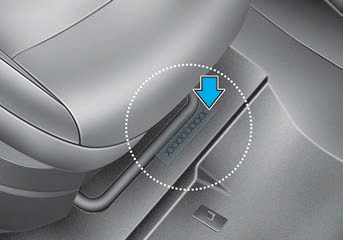Hyundai Venue: Maintenance / Tires and Wheels
Hyundai Venue (QX) (2020-2025) Owners Manual / Maintenance / Tires and Wheels
WARNING
Tire failure may cause loss of vehicle control resulting in an accident. To reduce risk of SERIOUS INJURY or DEATH, take the following precautions:
- Inspect your tires monthly for proper inflation as well as wear and damage.
- The recommended cold tire pressure for your vehicle can be found in this manual and on the tire label located on the driver’s side center pillar. Always use a tire pressure gauge to measure tire pressure. Tires with too much or too little pressure wear unevenly causing poor handling.
- Check the pressure of the spare every time you check the pressure of the other tires on your vehicle.
- Replace tires that are worn, show uneven wear, or are damaged. Worn tires can cause loss of braking effectiveness, steering control, or traction.
- ALWAYS replace tires with the same type, size, brand, construction and tread pattern as each tire that was originally supplied with this vehicle. Using tires and wheels other than the recommended sizes could cause unusual handling characteristics, poor vehicle control, or negatively affect your vehicle’s Anti-Lock Brake System (ABS) resulting in a serious accident.
Tire Care
For proper maintenance, safety, and maximum fuel economy, you must always maintain recommended tire inflation pressures and stay within the load limits and weight distribution recommended for your vehicle.

All specifications (sizes and pressures) can be found on a label attached to the driver’s side center pillar.
- Recommended Cold Tire Inflation Pressures
- Check Tire Inflation Pressure
- Tire Rotation
- Wheel Alignment and Tire Balance
- Tire Replacement
- Wheel Replacement. Tire Traction. Tire Maintenance
- Tire Sidewall Labeling
- Tire Terminology and Definitions
- All Season Tires. Summer Tires. Snow Tires
- Radial-Ply Tires
- Low Aspect Ratio Tires
 Battery
Battery
WARNING
To prevent SERIOUS INJURY or DEATH to you or bystanders, always follow these
precautions when working near or handling the battery:
Always read and follow instructions carefully when handling a battery...
 Recommended Cold Tire Inflation Pressures
Recommended Cold Tire Inflation Pressures
All tire pressures (including the spare) should be checked when the tires are
cold. “Cold tires” means the vehicle has not been driven for at least three hours
or has been driven for less than one mile (1...
Other information:
Hyundai Venue (QX) (2020-2025) Owners Manual: Seat Belt Restraint System
WARNING Improperly positioned seat belts may increase the risk of serious injury in an accident. Take the following precautions when adjusting the seat belt: Position the lap portion of the seat belt as low as possible across your hips, not on your waist, so that it fits snugly...
Hyundai Venue (QX) (2020-2025) Owners Manual: Air bag non-inflation conditions
In certain low-speed collisions the air bags may not deploy. The air bags are designed not to deploy in such cases because they may not provide benefits beyond the protection of the seat belts. Front air bags are not designed to inflate in rear collisions, because occupants are moved backward by the force of the impact...
Categories
- Manuals Home
- 1st Generation Venue Owners Manual
- 1st Generation Venue Service Manual
- Operating Door Locks from Outside the Vehicle
- Automatic Door Lock and Unlock Features
- Trip Computer
- New on site
- Most important about car
Vehicle Identification Number (vin), Vehicle Certification Label
Vehicle Identification Number (vin)

Frame number
Copyright © 2025 www.hvenueqx.com
